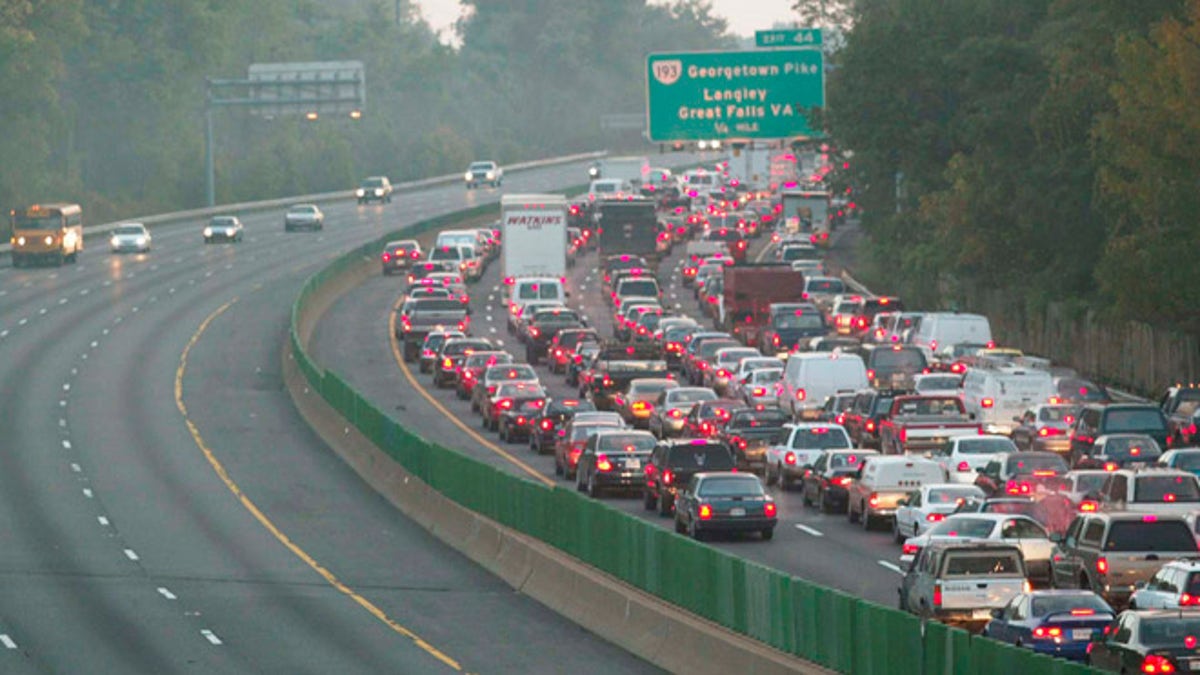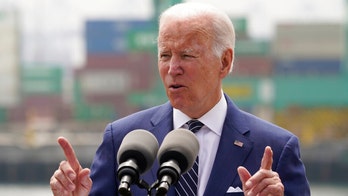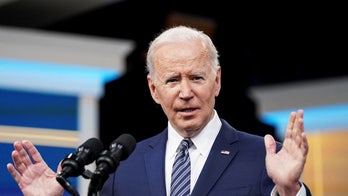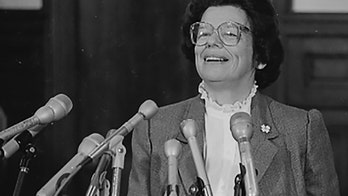
Traffic is backed up on the Washington Beltway entering Montgomery County, Maryland from Virginia, October 22, 2002. (Reuters)
A half-century ago this week, a major infrastructure project awarded the American electorate one of its favorite political scapegoats: The Beltway.
Americans naturally disdain Washington, holding the capital in contempt for its insular nature. For them, perhaps there’s only one thing worse than being “inside the Beltway.”
That would be if Washington were ensconced by three beltways.
After all, that was the original plan. Build one circuit around the District of Columbia and its suburbs. Then assemble another concentric coil a little further out. Finally, ring that with yet another radial in what are now the Maryland and Virginia exurbs.
Think the public’s worked up now about how things operate in Washington? Imagine a trinity of beltways walling off what voters perceive as an out-of-touch Washington.
For the good of the republic, maybe it’s best no one ever built those outer, outer, outer loops. (Optimists might find solace in the fact that Dante wrote of nine layers of hell while urban planners only intended three for Washington.)
But for those who can’t stand anything “inside the Beltway,” they can cast aspersions on a favorite whipping boy responsible for the whole thing: Congress.
Congress approved a bill in 1954 to “direct the construction of bridges over the Potomac River, and for other purposes.” Two years later, lawmakers okayed The Federal-Aid Highway Act of 1956. It authorized the construction of 47,000 miles of highways throughout the U.S. The 64-mile circumference cocooning Washington was but a part of that. But with little doubt, “The Capital Beltway” and what goes on inside is the most-discussed allocation in the entire interstate system.
The Beltway opened in August 1964. And uniquely, one can track American suspicions about Washington to that same time period. President Lyndon Johnson took over after President’s Kennedy’s assassination less than a year earlier. Just two weeks before the Beltway witnessed its first traffic jam came the Gulf of Tonkin Incident. North Vietnamese navy vessels engaged the USS Maddox in the Gulf of Tonkin. The episode prompted Congress to approve the Gulf of Tonkin Resolution on Aug. 7, 1964, granting the president authority to act militarily in Southeast Asia.
That scenario lit a very long fuse which led to “Vietnam” for the U.S. Critics maligned the Gulf of Tonkin resolution as giving the president too much latitude to act in Southeast Asia without Congress formally declaring war. Opposition to the conflict and the draft prompted the anti-war movement.
Also in the spring and summer of 1964, Congress approved the Civil Rights Act. Opponents inflamed the South in the coming years. Alienation came to head in 1968 with the assassinations of Robert F. Kennedy and Martin Luther King, Jr. Come 1970, there were “Four Dead in Ohio.” Watergate later deepened America’s mistrust in Washington and what goes on “inside the Beltway.”
The public barely looked back as it wrestled Iran-Contra, the impeachment of a president and unending wars in Iraq and Afghanistan. That’s to say nothing of contemporary scandals at the IRS, Veterans Affairs Department and various agencies over Benghazi.
Yet much of this dissent can be traced to the very period they opened the Beltway.
Washington’s pollsters, reporters, lawmakers, policymakers, think tankers often talk about “getting outside the Beltway” to capture the essence of America. These denizens believe spending too much time “inside the Beltway” is toxic. Analogous to consuming too much sodium or an overexposure to UVA rays in a tanning bed. Naturalized Beltway dwellers are seemingly required to retire to bucolic domains like “Wisconsin” or “Vermont.” There they inhale pristine bailiwicks far from the Beltway scourge. Romanticized places purportedly furnished with shrines called “kitchen tables.” To hear people in Washington tell it, these “kitchen tables” are altars around which those “outside the Beltway” constantly caucus when reaching great family decisions.
“Inside the Beltway” inhabitants pine to replicate the sage wisdom meted out at these councils.
These “outside the Beltway” safaris supposedly arm the Beltway tribe with reconnaissance about decisions they should make “inside the Beltway” – ostensibly to benefit those “outside the Beltway.” Yet those “outside the Beltway” are rarely satisfied and constantly crow about those “inside the Beltway.”
It’s a vicious cycle. Or circle, as the case may be.
Capitol Attitude is a weekly column written by members of the Fox News Capitol Hill team. Their articles take you inside the halls of Congress, and cover the spectrum of policy issues being introduced, debated and voted on there.




